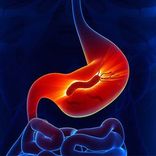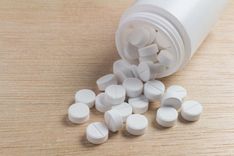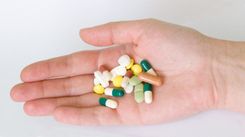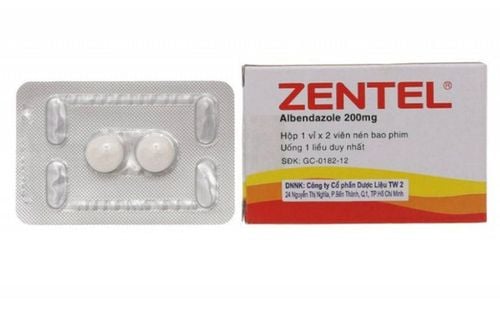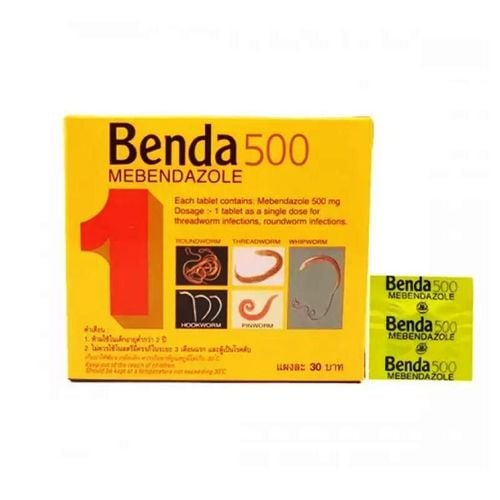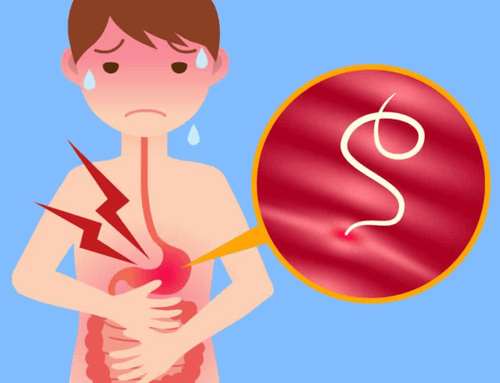Pyrantel 125mg contains the active ingredient Pyrantel, which works as a depolarizing neuromuscular blocker, leading to the paralysis of intestinal parasites. The medication is indicated for the treatment of pinworms, hookworms, roundworms, and threadworms.
1. What is Pyrantel 125mg?
Pyrantel 125mg contains Pyrantel as the main active ingredient at a dosage of 125mg. The mechanism of action involves releasing acetylcholine and inhibiting cholinesterase, resulting in a neuromuscular blockade that paralyzes worms. These paralyzed worms are then expelled from the intestines through normal peristalsis. Pyrantel is highly effective against Ascaris lumbricoides, Enterobius vermicularis, Trichinella spiralis, Trichostrongylus spp., and Ancylostoma duodenale and Necator americanus. However, it is ineffective against Trichuris trichiura.
Absorption of Pyrantel through the gastrointestinal tract is minimal. Peak plasma concentrations are achieved within 1–3 hours after oral administration. The drug undergoes partial metabolism in the liver, with more than 50% of the dose excreted unchanged in the feces. Less than 7% of the administered dose is eliminated via urine in its unchanged or metabolized form.
2. Indications for Pyrantel
Pyrantel is indicated for the treatment of infections caused by pinworms, hookworms, roundworms, and threadworms.
3. Contraindications of Pyrantel
Pyrantel is contraindicated in the following cases:
- Hypersensitivity to any of the components of the medication.
- Children under the age of 2, as its safety profile has not been established for this age group.
4. Dosage and Administration of Pyrantel
4.1 For Adults
- Roundworm, pinworm, hookworm, and Trichostrongylus infections: A single dose of 10mg/kg (up to a maximum of 1g). A repeat dose after 2–4 weeks enhances effectiveness.
- Hookworm infections: Either 20mg/kg daily (maximum 1g per dose) for two consecutive days or 10mg/kg daily (maximum 1g per dose) for three consecutive days.
- Isolated roundworm infections: A single dose of 5mg/kg (up to a maximum of 1g).
- Trichinosis infections: 10mg/kg daily (maximum 1g per dose) for five consecutive days.
4.2 For Children Over 2 Years Old
- Roundworm and hookworm infections: 10mg/kg daily for three days (maximum 1g per dose).
- Streptobacillus moniliformis infections: 11mg/kg per dose every two weeks for three doses.
- Pinworm infections: To prevent reinfection, treat the entire family simultaneously.
- Hookworm infections: A single dose of 20mg/kg daily for two consecutive days, or 10mg/kg daily for three consecutive days.
Isolated roundworm infections: A single dose of 5mg/kg. - Trichinosis infections: 10mg/kg daily for five consecutive days.
Administration tips: For best results, take Pyrantel between meals. The medication can be ingested with milk or fruit juice. There is no need for fasting, special diets, or the use of laxatives before or after treatment.
5. Side Effects of Pyrantel
Patients may experience the following side effects when using Pyrantel:
- Central Nervous System: Dizziness, headaches, insomnia. Alcohol consumption may exacerbate dizziness.
- Gastrointestinal: Abdominal cramps, nausea, vomiting, diarrhea.
- Other: Skin rash, elevated liver enzyme levels.
6. Precautions When Using Pyrantel
When using Pyrantel, patients should consider the following:
- Use Pyrantel cautiously in patients with impaired liver function.
- Exercise caution in malnourished or severely anemic patients. It is advisable to stabilize hydration, anemia, or nutritional deficiencies before administering Pyrantel.
- Pyrantel may induce toxic effects, such as increased alcohol levels, lactic acidosis, seizures, or respiratory depression, particularly in children and adults.
- For pinworm infections: Treat all household members to prevent reinfection. Ensure rigorous hygiene practices, such as regular handwashing, trimming nails, wearing tight-fitting underwear day and night, vacuuming or cleaning bedroom floors, and frequently washing bed linens and clothing after treatment.
- Overdose symptoms: Difficulty breathing, seizures, severe muscle spasms, or muscle weakness may indicate an overdose. Seek immediate medical attention in such cases.
- Pregnancy and Lactation: The use of Pyrantel during pregnancy has not been extensively studied. While no adverse effects on newborns have been reported, the drug should only be used during pregnancy when clearly needed and preferably after the first trimester.
- Driving and Operating Machinery: Pyrantel may cause dizziness or drowsiness, so patients should exercise caution when driving, operating heavy machinery, or engaging in activities requiring alertness.
- Drug Interactions: Pyrantel may interact with certain medications, altering its activity or exacerbating side effects. Avoid concurrent use with piperazine, as the two drugs have opposing effects on parasites. Similarly, avoid combining Pyrantel with products containing phenylalanine.
This article has provided an overview of the uses, dosage, and precautions of Pyrantel. To ensure safe and effective use, patients are advised to consult their doctor or pharmacist before taking this medication.
To arrange an appointment, please call the HOTLINE or make your reservation directly HERE. You may also download the MyVinmec app to schedule appointments faster and manage your reservations more conveniently.

